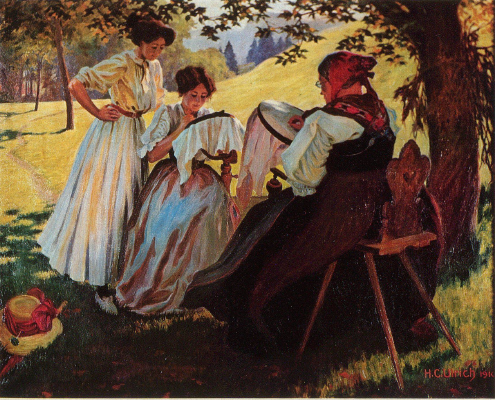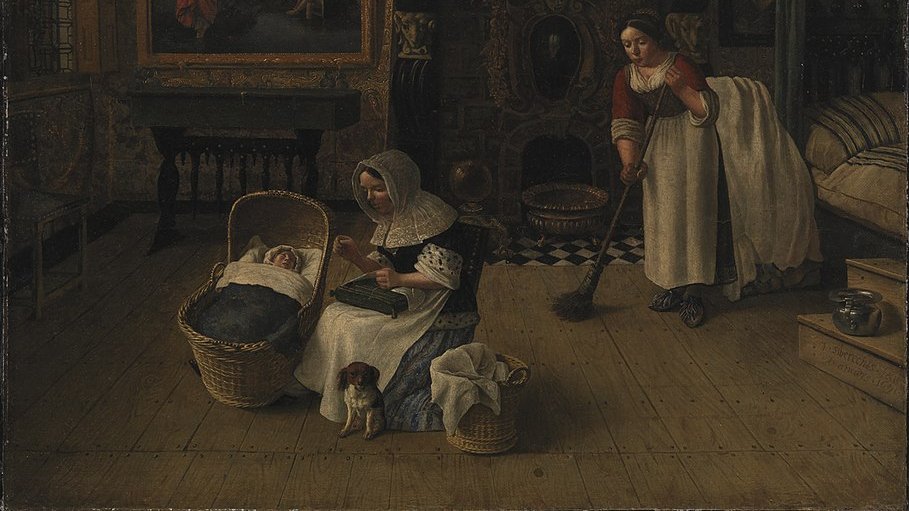As a break from your doom-scrolling, a thread on embroidery in historical and historically-inspired fantasy fiction. Something I really hate is the way it's often used in these genres to show that a female character is or isn't interesting.
Every heroine knows instinctively that sewing is boring, difficult, mindless, and pointless. Disliking it shows that she's an independent woman whose values align with the modern reader; characters who like/tolerate it are sheeplike and either minor or oppressive.
In The Subversive Stitch, Rozsika Parker notes that “embroidery has become indelibly associated with stereotypes of femininity ... mindless, decorative and delicate; like the icing on the cake, good to look at, adding taste and status, but devoid of significant content.”
The stereotype wasn't invented in the present day by women who hated the idea of being forced to do a certain craft. “Eighteenth-century critical commentators held [it] responsible for the ill health which was claimed as evidence of women’s natural weakness and inferiority.”
The first problem I have with the trope is that it presents needlework as busywork - something done because women had nothing worthwhile to do and have to distract themselves with something simple. (Yes, this is a callout of #Bridgerton  .)
.)
 .)
.)
Part of what drives this stereotype is the idea that what women were embroidering was either a sampler or a picture - something to do and then put away or hang on the wall and not look at.
These things were generally made by girls at school or being taught at home, as practice and something to show for all their hard work - not just the stitching, but also often watercolors worked into the design, artistic sensibility, and the lit/history/art alluded to in it.
What adult women were usually doing was embroidery that had some purpose. Upholstery for chairs, bedcurtains and coverlets, firescreens ...
And of course, clothing - particularly white embroidery on muslin, which required a lot of skill. Collars, cuffs, pelerines, undersleeves, chemisettes, ruffles ...
And pieces for family members, like wallets, slippers, waistcoats, and smoking caps for husbands, fathers, and brothers ...
There are a number of reasons why women embroidered these themselves, from obligation to simple enjoyment. It’s no different than people today who knit their own hats and gloves or bake their own bread, except that it was way more mainstream.
The second problem is that it's presented as the only "useless", impractical thing required of women in the setting, except maybe the even-more-deplored act of flower arranging.
Young ladies were expected to be “accomplished” to be marriageable. This could include skills like embroidery, drawing, painting, singing, playing the piano (as well as other instruments, like the harp or the mandolin), and speaking French (if not also Italian and/or German).
It also included broader knowledge and abilities like being well-versed in music, literature, and poetry; dancing and walking gracefully; writing good letters in an elegant hand; and being able to read out loud expressively and smoothly.
What ties all of these accomplishments together is their lack of value on the labor market. They trained a woman for the social and domestic role of a married woman of the upper middle or upper class, or, if she couldn’t get married, a governess or teacher.
There are reasons that a character might object to embroidery, but it was far from the only thing that an unconventional heroine would be required to do against her inclination. It's just that most of the other accomplishments are now valued as gender-neutral arts and skills.
If your heroine doesn’t like embroidery, she probably doesn’t like a number of other things she’s expected to do. Does she hate to sit still? I’d imagine she also dislikes drawing and practicing the piano.
Does she want to do more intense academics? She probably also resents learning modern languages and music. Does she hate enforced femininity? Then she’d most likely have a problem with all of the accomplishments.
If your heroine just and specifically doesn’t like embroidery, try to show in the narrative that that’s not because it’s objectively bad, and only able to be liked by the boring. Have another sympathetic character do it while talking to the heroine.
Note that the hero carries a flame-stitched wallet that’s his sister’s work. Emphasize the heroine’s emotional connection to her deceased or absent mother through her affection for clothing or upholstery that her mother embroidered.
And of course there's the option of a embroidered mourning picture commemorating someone's death. There are all kinds of things you can do to show that it’s a personal preference rather than a stupid craft that doesn’t take talent and skill!
If you want to read this in long form, it's based on a Tumblr post I made the other day: https://mimicofmodes.tumblr.com/post/639763936003178496/the-ladies-waldegrave-by-joshua-reynolds-1780

 Read on Twitter
Read on Twitter

![The stereotype wasn't invented in the present day by women who hated the idea of being forced to do a certain craft. “Eighteenth-century critical commentators held [it] responsible for the ill health which was claimed as evidence of women’s natural weakness and inferiority.” The stereotype wasn't invented in the present day by women who hated the idea of being forced to do a certain craft. “Eighteenth-century critical commentators held [it] responsible for the ill health which was claimed as evidence of women’s natural weakness and inferiority.”](https://pbs.twimg.com/media/ErZSD8gXIAAFswF.jpg)














